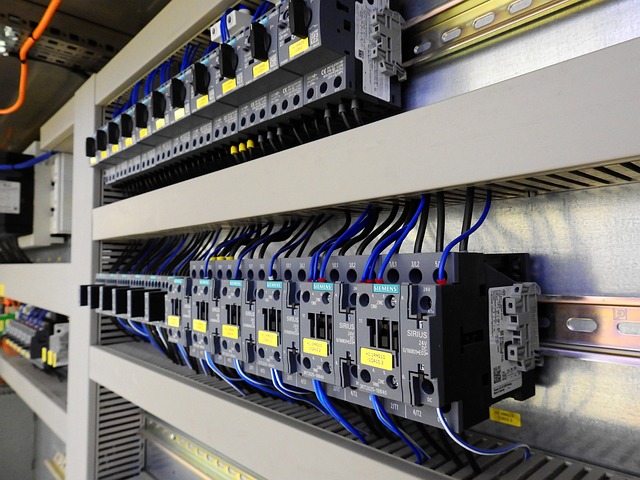“Empowering Solar Safety: Circuit Breakers as Your First Line of Defense.”
Circuit breakers play a crucial role in solar wiring systems by providing essential protection and safety for both the solar panels and the electrical components of the system. They act as automatic switches that interrupt the flow of electricity in the event of an overload, short circuit, or other electrical faults, preventing potential damage and hazards. Understanding the function and importance of circuit breakers in solar installations is vital for ensuring the reliability and efficiency of solar energy systems, as well as for complying with safety regulations and standards. Properly selected and installed circuit breakers enhance the overall performance of solar energy systems, safeguarding both the equipment and the users.
Importance of Circuit Breakers in Solar Systems
In the realm of solar energy systems, the importance of circuit breakers cannot be overstated. These devices serve as critical components that ensure the safety and efficiency of solar installations. By understanding their role, one can appreciate how circuit breakers contribute to the overall functionality and reliability of solar energy systems.
To begin with, circuit breakers act as protective devices that automatically interrupt the flow of electricity in the event of an overload or short circuit. This is particularly vital in solar systems, where fluctuations in energy production can occur due to varying sunlight conditions. When solar panels generate more electricity than the system can handle, circuit breakers prevent potential damage to the wiring and connected components. This protective mechanism not only safeguards the equipment but also enhances the longevity of the entire solar installation.
Moreover, circuit breakers play a crucial role in ensuring the safety of individuals working with or around solar systems. In the event of a fault, such as a short circuit, the circuit breaker will trip, cutting off the electrical supply and reducing the risk of electrical fires or shocks. This safety feature is especially important in residential and commercial settings, where the presence of people and property necessitates stringent safety measures. By incorporating circuit breakers into solar wiring, installers can provide peace of mind to homeowners and businesses alike, knowing that their systems are equipped to handle unexpected electrical issues.
In addition to safety, circuit breakers also facilitate maintenance and troubleshooting within solar systems. When a circuit breaker trips, it serves as an immediate indicator that something is amiss, allowing technicians to quickly identify and address the underlying issue. This not only minimizes downtime but also ensures that the solar system can return to optimal performance as swiftly as possible. Furthermore, the ability to isolate specific sections of the system through circuit breakers enables maintenance personnel to work safely without shutting down the entire installation, thereby enhancing operational efficiency.
Transitioning from safety and maintenance, it is essential to consider the role of circuit breakers in optimizing energy management within solar systems. By integrating smart circuit breakers, which can monitor energy flow and provide real-time data, users can gain valuable insights into their energy consumption patterns. This information can be instrumental in making informed decisions about energy usage, ultimately leading to increased efficiency and cost savings. As solar technology continues to evolve, the integration of advanced circuit breakers will likely become more prevalent, further enhancing the capabilities of solar energy systems.
In conclusion, the significance of circuit breakers in solar wiring extends far beyond mere protection. They are integral to ensuring safety, facilitating maintenance, and optimizing energy management. As the demand for renewable energy sources continues to grow, understanding the role of circuit breakers will be essential for anyone involved in the design, installation, or maintenance of solar systems. By prioritizing the inclusion of high-quality circuit breakers, stakeholders can enhance the reliability and efficiency of solar installations, paving the way for a more sustainable energy future. Ultimately, circuit breakers are not just components; they are vital guardians of the solar energy landscape, ensuring that systems operate safely and effectively in an ever-evolving energy environment.
Types of Circuit Breakers Used in Solar Wiring

In the realm of solar energy systems, circuit breakers play a pivotal role in ensuring safety and efficiency. Understanding the various types of circuit breakers used in solar wiring is essential for anyone involved in the design, installation, or maintenance of solar power systems. These devices serve as protective mechanisms that prevent overloads and short circuits, thereby safeguarding both the solar equipment and the overall electrical system.
One of the most common types of circuit breakers utilized in solar wiring is the DC circuit breaker. Unlike traditional AC circuit breakers, which are designed for alternating current, DC circuit breakers are specifically engineered to handle the unique characteristics of direct current generated by solar panels. This distinction is crucial because DC circuits can create arcing when interrupted, which can lead to equipment damage or fire hazards. Therefore, DC circuit breakers are equipped with features that minimize arcing and ensure a reliable disconnection of the circuit when necessary.
In addition to DC circuit breakers, another important type is the AC circuit breaker. These are typically used in the inverter section of a solar power system, where the direct current produced by the solar panels is converted into alternating current for use in homes and businesses. AC circuit breakers are designed to protect the inverter and the connected loads from overloads and faults. They are essential for maintaining the integrity of the electrical system, as they can quickly disconnect the power supply in the event of a fault, thus preventing potential damage to the inverter and other components.
Moreover, there are also combination circuit breakers that integrate both AC and DC protection in a single unit. These are particularly advantageous in hybrid systems where both types of current are present. By using a combination circuit breaker, installers can simplify the wiring process and reduce the number of components needed, which can lead to cost savings and a more streamlined installation. This type of breaker is especially useful in larger solar installations where space and efficiency are critical considerations.
Another noteworthy type of circuit breaker is the ground fault circuit interrupter (GFCI). GFCIs are designed to protect against ground faults, which occur when there is an unintended path between the electrical current and the ground. In solar systems, GFCIs are crucial for preventing electrical shocks and ensuring the safety of personnel working on or near the solar installation. They continuously monitor the current flowing through the circuit and can quickly disconnect the power if an imbalance is detected, thereby providing an additional layer of safety.
As solar technology continues to evolve, so too do the circuit breakers that support these systems. Innovations in circuit breaker design and functionality are enhancing their reliability and efficiency. For instance, smart circuit breakers are emerging, which can provide real-time monitoring and diagnostics, allowing for proactive maintenance and improved system performance. These advancements not only enhance safety but also contribute to the overall effectiveness of solar energy systems.
In conclusion, understanding the various types of circuit breakers used in solar wiring is essential for ensuring the safety and efficiency of solar power systems. From DC and AC circuit breakers to combination units and GFCIs, each type serves a specific purpose in protecting the system from faults and overloads. As the solar industry continues to grow, the importance of these protective devices will only increase, making it imperative for stakeholders to stay informed about the latest developments in circuit breaker technology.
How Circuit Breakers Protect Solar Installations
In the realm of solar energy systems, circuit breakers play a pivotal role in ensuring the safety and efficiency of solar installations. As solar power continues to gain traction as a sustainable energy source, understanding the function of circuit breakers becomes increasingly important for both homeowners and professionals in the field. At their core, circuit breakers serve as protective devices that interrupt the flow of electricity in the event of an overload or short circuit, thereby preventing potential damage to the solar system and reducing the risk of fire hazards.
When solar panels generate electricity, the current flows through various components, including inverters and batteries, before reaching the electrical grid or being used to power appliances. However, fluctuations in energy production, such as those caused by sudden changes in sunlight or equipment malfunction, can lead to excessive current flow. This is where circuit breakers come into play. By monitoring the electrical current, they can detect anomalies and automatically disconnect the circuit when necessary, effectively safeguarding the entire system.
Moreover, circuit breakers are essential for maintaining the longevity of solar installations. Over time, components can wear down or become less efficient, leading to increased resistance and potential overheating. Without circuit breakers, these issues could escalate, resulting in costly repairs or even complete system failure. By interrupting the current flow during such events, circuit breakers not only protect the equipment but also ensure that the solar installation continues to operate at optimal performance levels.
In addition to protecting against overloads, circuit breakers also play a crucial role in ensuring compliance with electrical codes and standards. Many jurisdictions require the installation of circuit breakers as part of the electrical system for solar energy systems. This requirement is not merely a formality; it reflects a broader commitment to safety and reliability in renewable energy installations. By adhering to these regulations, solar installers can provide peace of mind to homeowners, knowing that their systems are equipped with the necessary safeguards.
Furthermore, the integration of circuit breakers into solar wiring enhances the overall safety of the installation. In the event of a fault, such as a ground fault or arc fault, circuit breakers can quickly isolate the affected section of the system. This rapid response minimizes the risk of electrical shock to maintenance personnel and reduces the likelihood of fire, which can be a significant concern in any electrical system. By ensuring that only the faulty section is disconnected, circuit breakers allow the rest of the solar installation to continue functioning, thereby maximizing energy production and minimizing downtime.
In conclusion, the role of circuit breakers in solar wiring cannot be overstated. They are integral to the safety, efficiency, and longevity of solar installations. By preventing overloads, ensuring compliance with safety standards, and providing rapid fault isolation, circuit breakers protect both the equipment and the individuals who interact with these systems. As the adoption of solar energy continues to grow, understanding the importance of these protective devices will be essential for anyone involved in the design, installation, or maintenance of solar power systems. Ultimately, circuit breakers not only enhance the reliability of solar installations but also contribute to the broader goal of promoting safe and sustainable energy solutions.
Best Practices for Circuit Breaker Installation in Solar Systems
When it comes to the installation of solar systems, the role of circuit breakers cannot be overstated. These devices serve as critical safety components, protecting both the solar equipment and the overall electrical system from potential faults and overloads. To ensure optimal performance and safety, adhering to best practices for circuit breaker installation is essential.
First and foremost, selecting the appropriate type of circuit breaker is crucial. In solar applications, two primary types are commonly used: DC circuit breakers and AC circuit breakers. DC circuit breakers are specifically designed to handle the unique characteristics of direct current generated by solar panels, while AC circuit breakers are used for the alternating current that flows to the grid or home. Understanding the differences between these types and their specific ratings is vital for ensuring compatibility with the solar system’s voltage and current levels.
Once the right circuit breaker has been chosen, the next step involves proper placement within the system. Circuit breakers should be installed in easily accessible locations, allowing for quick intervention in case of an emergency. This accessibility is not only important for maintenance but also for safety, as it enables users to disconnect the system swiftly if necessary. Additionally, it is advisable to install circuit breakers in a weatherproof enclosure, especially in outdoor settings, to protect them from environmental factors that could compromise their functionality.
Moreover, ensuring that the circuit breakers are rated for the specific load they will handle is another best practice. Each circuit breaker has a maximum current rating, and exceeding this limit can lead to overheating and potential failure. Therefore, it is essential to calculate the expected load accurately and select breakers that can handle this load with a suitable margin. This practice not only enhances safety but also prolongs the lifespan of the circuit breakers and the solar system as a whole.
In addition to proper selection and placement, the installation process itself must be executed with precision. All connections should be made securely, using appropriate wiring techniques to prevent loose connections that could lead to arcing or overheating. Furthermore, it is advisable to follow the manufacturer’s guidelines and local electrical codes during installation. Compliance with these regulations not only ensures safety but also facilitates smoother inspections and approvals from local authorities.
Another important aspect to consider is the integration of monitoring systems with circuit breakers. Modern solar systems often include monitoring capabilities that allow users to track performance and detect issues in real time. By integrating circuit breakers with these monitoring systems, users can receive alerts about potential problems, enabling proactive maintenance and reducing the risk of system failures.
Finally, regular maintenance and testing of circuit breakers are essential to ensure their continued effectiveness. Periodic inspections can help identify wear and tear, corrosion, or other issues that may compromise the circuit breaker’s performance. By addressing these concerns promptly, system owners can maintain a safe and efficient solar installation.
In conclusion, the installation of circuit breakers in solar systems is a critical component that requires careful consideration and adherence to best practices. From selecting the right type and rating to ensuring proper placement and secure connections, each step plays a vital role in safeguarding the solar system. By following these guidelines, solar system owners can enhance safety, improve performance, and ultimately enjoy the benefits of renewable energy with peace of mind.
Q&A
1. **What is the primary function of circuit breakers in solar wiring?**
Circuit breakers protect the solar power system from overloads and short circuits by interrupting the flow of electricity when a fault is detected.
2. **How do circuit breakers enhance safety in solar installations?**
They prevent potential fire hazards and equipment damage by automatically disconnecting the electrical circuit in case of abnormal conditions.
3. **What types of circuit breakers are commonly used in solar systems?**
Common types include DC circuit breakers for the solar array and AC circuit breakers for the inverter output to the grid or home.
4. **Why is it important to select the correct rating for circuit breakers in solar wiring?**
Selecting the correct rating ensures that the circuit breaker can handle the maximum expected current without tripping under normal conditions while still providing protection during faults.
Conclusion
Circuit breakers play a crucial role in solar wiring by providing overcurrent protection, ensuring safety, and enhancing the reliability of solar power systems. They prevent damage to electrical components and reduce the risk of fire hazards by interrupting the flow of electricity in case of faults or overloads. Additionally, circuit breakers facilitate maintenance and troubleshooting by allowing sections of the system to be de-energized without shutting down the entire solar installation. Overall, understanding the function and importance of circuit breakers is essential for the safe and efficient operation of solar energy systems.



